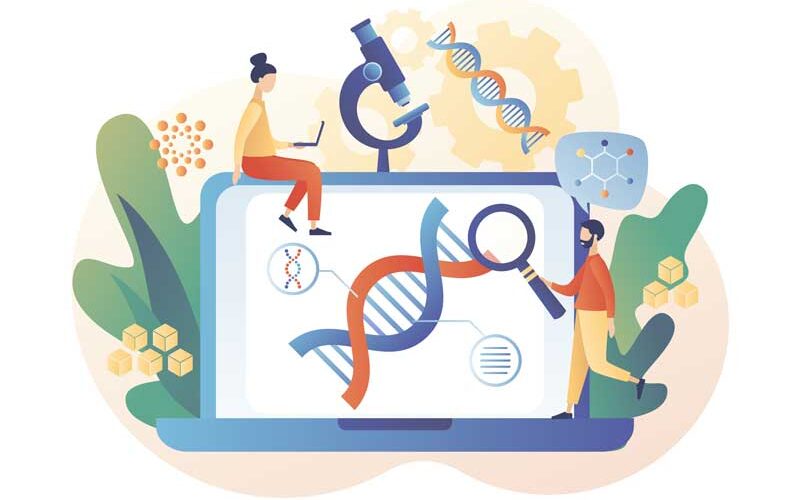Through the development and use of site-specific nuclease technologies, the researchers at Creative Biolabs are revolutionizing basic science and personalized medicine. We offer TALEN (transcription activator-like effector nucleases) and CRISPR-Cas9 system services to our clients all over the world. They enable the alteration, addition, or deletion of genes in numerous cell types and species. Opportunities to alter and study model organisms have significantly grown as a result of these ground-breaking technologies. We can contribute to realizing the promise of correcting the inherited causes of many diseases (Bi and Yang, 2017).
Principles and Applications of Tans and CRISPR-Cas9
– TALENs
The FokI cleavage domain and DNA-binding domains of TALE proteins are combined to form TALENs. A TALENs core repeat domain is made up of repeating units that are 33–35 amino acids long. Targeted DNA damage breaks (DSBs) caused by TALENs activate DNA damage response pathways, allowing for customized modifications. TALENs stand for a unique class of modular, highly specialized artificial nucleases. TALENs’ modular construction and simple DNA recognition code make them an ideal platform for targeted gene repair. In a variety of human cell types, it has been demonstrated that TALENs are a dependable, targeted, and typically secure genome engineering approach (Sundaram, 2023) for accomplishing precise gene targeting and alteration.
– CRISPR-Cas9
Numerous short direct repeats are found in CRISPR (clustered regularly interspaced short palindromic repeats) system loci, which give bacteria and archaea acquired immunity. CRISPR systems introduce sequence-specific silencing of invasive foreign DNA based on crRNA and tracrRNA. The CRISPR/Cas systems have quickly evolved from a specialized technology to a widely utilized technique by many biologists. With this service, endogenous genes may be quickly, easily, and successfully changed in a variety of cell types with important medical applications, as well as in species that have previously been challenging to genetically modify. A modified variant of the CRISPR-Cas9 system has also been shown to be capable of enlisting heterologous domains that can regulate endogenous gene expression or mark specific genomic areas in living cells (Redman and King and Watson and David, 2016).
Ethical Issues and Concerns
The enormous potential of gene editing raises moral dilemmas. Controversial topics include chromosomal editing, unexpected off-target effects, and equal access to these technologies. We must weigh the risks and benefits in order to make morally sound decisions. For scientists, ethicists, decision-makers, and the general public to traverse these challenges, cross-disciplinary cooperation is required. More research is needed to determine the detrimental effects on the mother, fetus, and future generations (Joseph and Karas, Ramadan, and Joubran and Jacobs, 2022).
Ethical Guidelines and Regulations
Around the world, policies and rules have been developed in an effort to solve ethical issues. Transparency, public participation, and accountability are emphasized in ethical frameworks. Combining these regulations promotes ethical research while guaranteeing a fair distribution of the advantages of gene editing. For the discipline to advance sustainably, the proper balance between encouraging innovation and respecting moral principles is essential (Kohn, Porteus, and Scharenberg, 2016).
Future Outlook and Possibilities
One can advocate for scientific progress while still urging appropriate prudence when using potent new technology. Before human germline genome editing is taken into consideration for use in medicine, much more research must be done to determine its safety and effects. In addition, when new information becomes available, it is important to evaluate the reasons for using the technology as well as related legal and ethical concerns. It will assist in resolving certain unresolved issues and usher in this new age with caution and responsibility if clinical trials are permitted to begin in this area under stringent regulation and without local legal loopholes (Nature Genetics, 2017).
Conclusion
Gene editing is a revolutionary force with significant ethical ramifications. Scientists, decision-makers, and society must work together to embrace the potential of new technologies while negotiating their difficult ethical issues. Together, we can use gene editing to advance mankind while respecting moral standards and defending our common values. We can make sure that gene editing continues to be a driver for good change in the years to come by encouraging ethical innovation.
References
Bi, H. and Yang, B. (2017). Chapter Five – Gene Editing With TALEN and CRISPR/Cas in Rice. [online] ScienceDirect. Available at: https://www.sciencedirect.com/science/article/abs/pii/S1877117317300662?via%3Dihub [Accessed 2 August 2023].
Joseph, A.M., Karas, M., Ramadan, Y., Joubran, E. and Jacobs, R.J. (2022). Ethical Perspectives of Therapeutic Human Genome Editing From Multiple and Diverse Viewpoints: A Scoping Review. Cureus, [online] 14(11). doi:https://doi.org/10.7759/cureus.31927. [Accessed 4 August 2023]
Kohn, D.B., Porteus, M.H. and Scharenberg, A.M. (2016). Ethical and regulatory aspects of genome editing. Blood, [online] 127(21), pp.2553–2560. doi:https://doi.org/10.1182/blood-2016-01-678136. [Accessed 4 August 2023]
Nature Genetics (2017). The future of human genome editing. Nature Genetics, [online] 49(5), pp.653–653. doi:https://doi.org/10.1038/ng.3860. [Accessed 4 August 2023]
Redman, M., King, A., Watson, C. and King, D. (2016). What Is CRISPR/Cas9? Archives of Disease in Childhood – Education & Practice Edition, [online] 101(4), pp.213–215. Available at: https://ep.bmj.com/content/101/4/213.short [Accessed 3 August 2023].
Sundaram, J. (2023). Transcription Activator-like Effector Nucleases (TALENs). [online] News-Medical.net. Available at: https://www.news-medical.net/life-sciences/TALENs.aspx [Accessed 3 August 2023].
